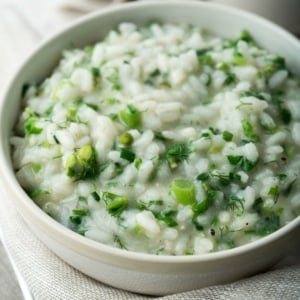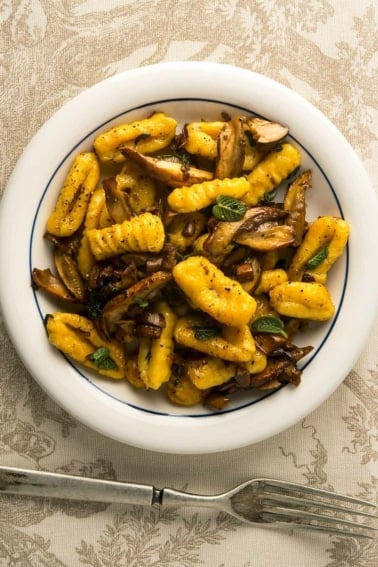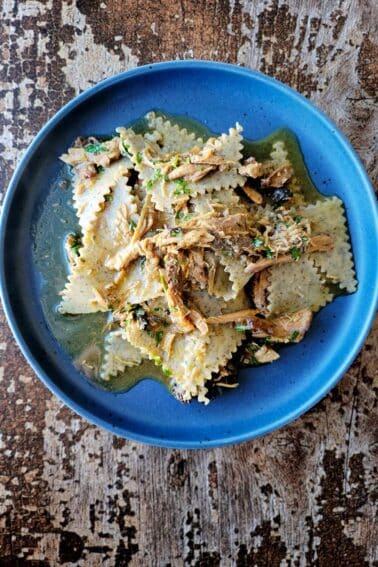As an Amazon Associate I earn from qualifying purchases.
Risotto is an Italian style of cooking rice that, when properly done, will give you a bowl of creamy goodness without the use of actual cream. What you do beyond cooking the rice is up to you. There are meaty risottos, mushroom risottos, seafood risotto, and any number of risotto recipes that feature seasonal ingredients.
This ramp risotto highlights the fresh green things of spring.

Onions and garlic are the backbone of this recipe. Specifically green onions and young garlic. Any sort of green onion works, from regular scallions to wild ramps, “lawn onions,” nodding onions, you name it.
If you do make this as a full-on ramps risotto, you can make this with just the leaves, although if you have them, you can sauté the bulbs in the beginning, as you would with scallions.
Fresh garlic, whether the pretty green garlic of earlier spring or what’s ripe now, which is fully formed garlic that has just been pulled from the ground. These fresh cloves are crunchy, and the flavor is warm, not biting or astringent, as old storage garlic can get.
Beyond that, toss green things into this bowl of rice right at the end of cooking. Any green will do, but this is a good place for wild greens, like lambsquarters, dandelions, wild lettuce, amaranth, orache. But spinach is a good alternate, as are turnip, beet or mustard greens. Chard will work, but kale is too burly.
My strong advice is to take your time when you cook the white parts of the onions, as well as the garlic. Slowly sweating the vegetables in butter helps them meld seamlessly into the rice. If you cook too fast, they will brown and discolor the risotto, or too short and they will be crunchy, which is off-putting.
If you’ve never made Italian risotto, I urge you to try it. It’s not like any other rice you’ve probably ever eaten; only Chinese congee comes close. Silky, yet the rice has a distinct bite. Creamy, yet there is no cream. Warmth and softness is balanced by the herbiness of all those greens.
Ramp risotto is meal in a bowl, yes, but is also a perfect match for grilled poultry or fish.
Ramp Risotto
Ingredients
- 1/4 cup unsalted butter, divided
- About 2 dozen wild onions, white and green parts separated
- 1 garlic clove, minced
- 1 1/2 cups arborio or other short-grain risotto rice
- Salt
- 1 cup white wine
- 1 cup chicken or vegetable broth
- 1/4 cup chopped greens, mustard, lamb's quarters, spinach, amaranth, etc
- 3 tablespoons minced fennel or dill fronds
- 1/3 cup grated parmigiano or pecorino cheese
Instructions
- Heat 3 tablespoons of the butter in a pot over medium heat. Cook the white parts of the onion in the butter gently, stirring often, until they are soft but not browned, about 6 minutes. Add the garlic and cook another minute. Add the rice and stir to coat with the butter. Cook over medium-high heat a couple minutes, until the rice gets a little bit translucent.
- Add the white wine and stir well. Sprinkle some salt over everything. From this point you need to stir pretty much constantly. When the wine has almost boiled away, add the chicken broth and repeat the process.
- When the chicken broth has almost boiled away, add a cup of water and repeat the stirring while the moisture boils away. You will likely need to do this at least 2 more times. Taste the rice after the second cup of water has mostly boiled away and add salt if needed. You want the rice to be al dente, not mushy.
- When the rice is almost done, stir in the chopped greens and the chopped green parts of the onions. Add a little more water -- you want the rice to be almost like oatmeal in consistency, more of a porridge than set-up rice. Add the fennel fronds and the grated cheese.
- Finally, right before you serve, stir in the final tablespoon of butter and adjust with a little more water if need be to loosen up the rice. Serve at once.
Notes
Nutrition
Nutrition information is automatically calculated, so should only be used as an approximation.






This is a winner. I only had ramp leaves, but used some scallion whites in place of the ramp bulbs. Added a ton of the ramp leaves and some spinach. Otherwise followed the recipe (or rather I threw ingredients in as my 13 year old stirred and monitored the liquid). Everyone loved this and I would absolutely make it again. Thanks, Hank.
I made and admired this recipe last spring, so when I was trying to figure out what to do with a batch of fermented leek greens from my wife’s garden, I came back to it, more or less. We used the whites for another dish, but I put the green tops, and the greenish middles, into brine and let them ferment for a few weeks. When I made the risotto, I basically used the pale-green parts like ramp bulbs, right at the beginning, and threw the dark-green tops in at the end, along with the butter and parmesan. I had decided not to add any salt – you know, brine – but a couple if large pinches at the end seemed necessary. We also threw in a bunch of shrimp at the last minute. But the fermented leek tops made the dish, a mellow, onion-ish flavour unlike any other Allium. Moral of the story: Save, or rather ferment, your leek tops.
I had my first experience with ramps over the weekend. I was a little suspicious of this risotto recipe because it called for a lot of water where I normally would have used more broth. I’m so glad I trusted the recipe (and Hank Shaw), because it was delicious and creamy, and the ramps were the real star of the dish. My wife says it was the best risotto I ever made. I’ll take that any time.
This is a really nice recipe to use your extra ramp leaves from making pickled ramp bulbs. We greatly enjoy this dish in spring. It’s relatively straightforward and uncomplicated if you’ve made risotto before.
Currently touring Croatia. Wild onions. So many that you can smell them as you walk through the forest. They make a lovely risotto.
My favorite thing to do with spring onions, or “lawn onions” as you describe here, is to use them in my grits. I only use the green tops. I never dig up the bulbs and even then I only cut off 1 leaf from each onion plant. I also don’t mow the onions but let them eventually bolt and produce seed. I collect the seeds and scatter them in a better place – where I’m less tempted to mow them.